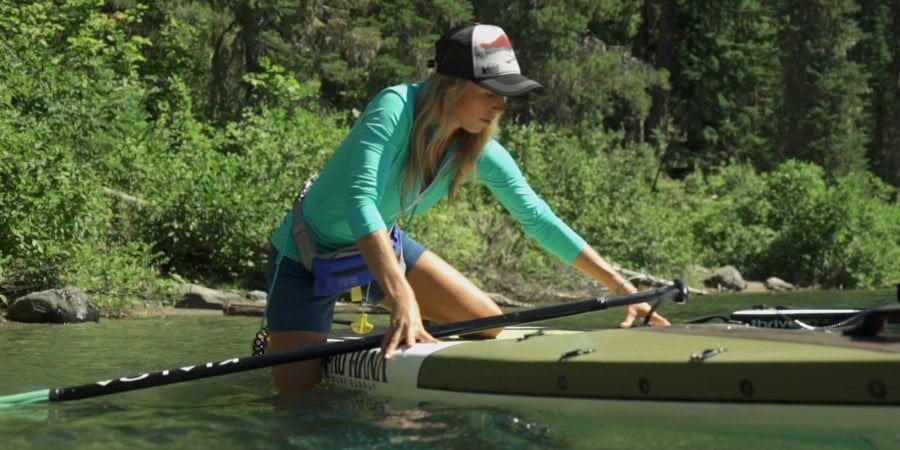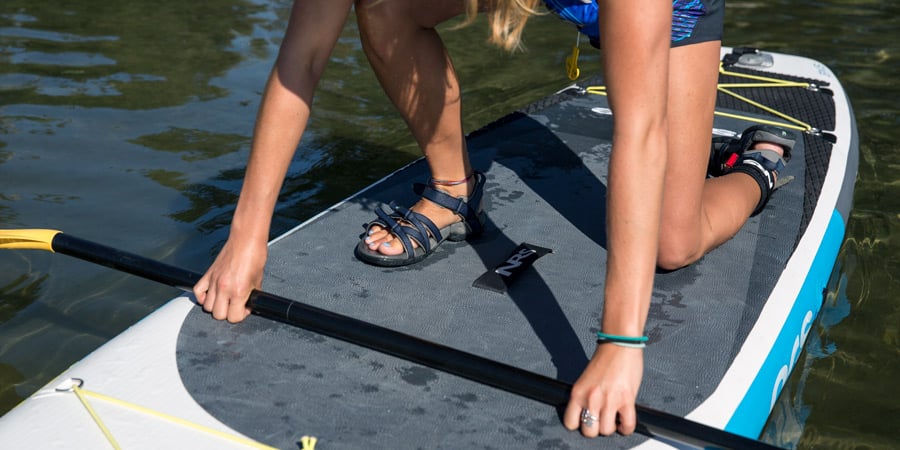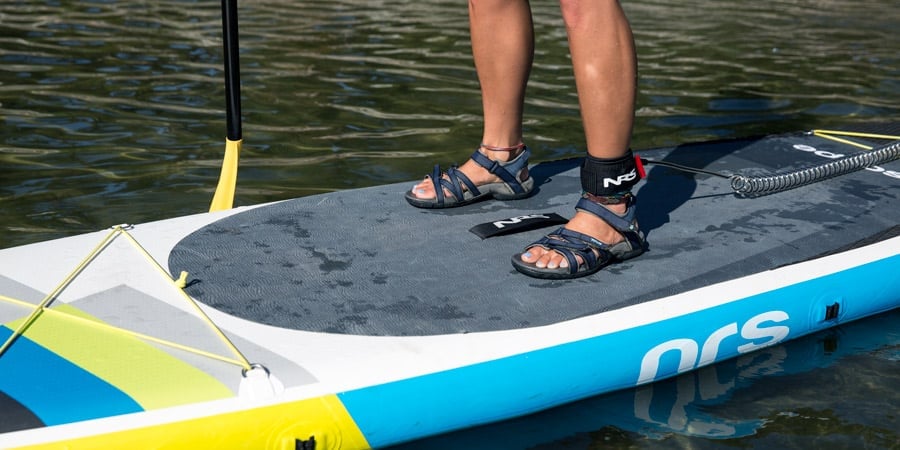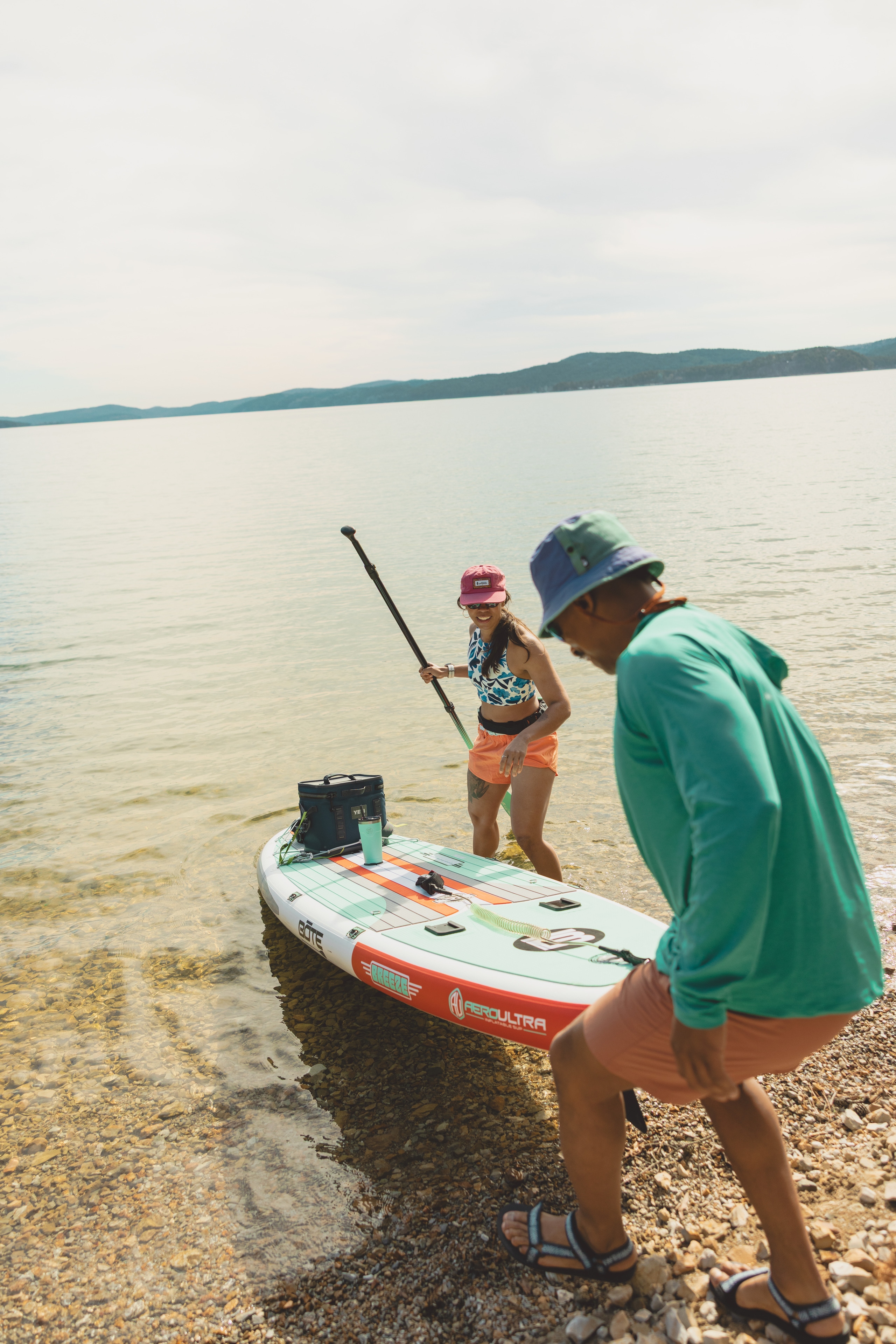If you're new to stand up paddle boarding, launching your board and standing up on it may seem intimidating. But, with some tips and a little practice you'll be paddling away like it's no big deal.
In this video, we teach you:
- How to launch your board: Carry your board into the water and start out on your knees or lying on your stomach.
- How to stand up on a SUP: From a kneeling position, move your feet to where your knees are and stand up by raising your chest and extending your legs.
- How to balance on a SUP: Standing over the carry handle with your knees slightly bent and your feet hip-width-distance apart will help you stay stable.
Video: Launching and Standing Up on a Paddle Board
How to Launch a SUP From the Shore

To launch your paddle board:
- Wade into knee-deep water: So that the fins on your SUP don't get damaged, carry your board out into about knee-deep water before you set it down. This should be deep enough to keep most fins from hitting the bottom.
- Start on your knees: Hold the board by the edges and work your way onto the board in a kneeling position, just behind the center of the board (you can quickly find the center by locating the carry handle).
- Or, lie down: If you're uneasy about starting in a kneeling position on your board, you can begin by lying down in the prone position and using your hands to paddle out, like a surfer. Stow your paddle by putting the blade under your chest with the power face against the board so that the shaft points diagonally up and toward the nose of the board.
- Use your paddle: When getting into a kneeling position, lay your paddle across your board so the blade touches the water. This can help stabilize the board.
- Move away from obstacles: Whether you're lying down or kneeling, paddle out so you're away from obstacles and in water that's deep enough that you won't hit anything if you fall in. If you are lying down, now work your way to your knees.
How to Launch a SUP from a Dock
Launching from a sandy beach is easiest, but if there isn't a convenient spot for you to wade in, you can launch your SUP from a dock. Here's how:
- Put your board in the water alongside the dock by setting the nose in the water then slowly lowering the board while holding on to the tail or the leash.
- With the board in the water, sit down on the dock and put your feet on the board near the carry handle.
- To get on, rotate your hips so that you can get your hands onto the edges of the board while your butt is still on the dock.
- Slowly work your knees onto the board about where your feet are. Focus on staying low while moving onto the board.
- From this position on all fours, you can either lie down in the prone position or stay kneeling. Push yourself away from the dock and start paddling.
How to Stand Up on a SUP

To stand up on your paddle board, start from a kneeling position on your board and then:
- Move one foot at a time: Put your hands on the sides of the board to stabilize it and move one foot at a time to place your feet where your knees are.
- Weight your hands: When moving from kneeling to standing, put the majority of your weight onto your hands so you'll feel more stable as you move your feet.
- Raise your chest and stand: With your feet on the board, rather than standing up in one motion, start by raising your chest up while keeping your knees bent. Once your chest is vertical, extend your legs to stand up.
- Practice on land: It can be helpful to practice standing up on land to get used to the movements without the instability of water. To do so, take the fin off your board and lay the board down on a soft surface, such as grass or sand. Lie down or kneel on the board and go through the motion of standing up.
How to Balance on a SUP

Once you're standing on your board, there are a handful of things you can do to help stay balanced:
- Find the right stance: Position your feet so they are parallel, about hip-width distance apart, and centered between the edges of the board. Keep your toes pointed forward, knees slightly bent and your back straight.
- Use your hips: Keep your head and shoulders steady and upright, and shift your weight by moving your hips. Let your lower body move independently of your upper body.
- Look ahead: Your gaze should be level at the horizon. Avoid staring at your feet.
- Use your paddle: Keep your paddle in the water as much as possible; it acts like an outrigger on a canoe to add stability.
- Relax your feet: It's natural to grip the board with your feet when you're feeling unstable, but doing so can lead to numb and/or tired feet. Focus on keeping your feet relaxed and not pressing them down into the board. Occasionally wiggle your toes and rock back and forth from heel to toe, or sit down on your board to give your feet a break.

